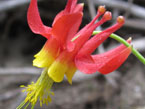Copyright & Revisions: Copyright © 1996. Reformatted in 2013. No changes made to text.
Publication History:Originally published in the Proceedings of 1992 and 1993 International Conferences on Outdoor Recreation. Citation: Watters, R. (1996). A computerized cataloging system for an outdoor program library or resource center . In Joyce, P. & Watters, R. (Eds.). Proceedings of 1992 and 1993 International Conferences on Outdoor Recreation (pp. 13-25). Pocatello, ID: Idaho State University Press.
Reproduction Information: You are welcome to provide links to this page or to use short quotations and paraphrases in other documents as long as they appropriately reference the source. There is no charge for non-profit organizations to reproduce or publish extensive parts or all of this paper, but please obtain advanced permission from Ron Watters (wattron@isu.edu). Photo credits: Ron Watters.
Editor's Note: Since this paper was written in the mid 1990's, there have been great advances in software and software programming languages. The software program described within this paper is very much old-style. The equipment mentioned — such as floppy disks and IBM AT computers — are now way out-dated. However, some users may find the descriptive information on the program's features and flow of logic helpful as they design their own software for record keeping. Abstract
A variety of IBM compatible software programs are available on the market which can be used by non profit organizations to maintain data bases and mailing lists. Without programming knowledge, however, these programs do not address the specific needs of outdoor programs. This paper describes a new software program, the Outdoor Program Data Base System (OPDBS), which has been designed and developed specifically for use in outdoor recreation and/or disabled programs. As long as the software is used by non-profit schools and organizations, there is no fee for its use.
Introduction
The process of maintaining mailing lists and other informational files on outdoor program participants is, plainly and simply, a pain in the neck. Mailing list maintenance is particularly difficult for programs that deal with university students. Most students move at least once a year, if not more, and one is faced with the nightmare of constantly revising and re-revising the list.
The use of a computer and proper software, however, can take some of the pain out of mailing list maintenance. The software primarily used to maintain mailing lists and participant files comes from a genre known as data base software. For IBM compatibles, software with such names as Dbase, FoxPro, Paradox, RBase, or Dataperfect, are examples of data base software. Any of these or similar products can be used by outdoor programs, but it means considerable time learning about the product and then making necessary adaptations to fit the specific needs of a recreational program.
The OPDBS software, developed at Idaho State University, addresses the specific needs of that program. However, with some minor changes that do not involve knowledge of programming, it can be adapted so that it more closely match needs of other programs. Part of the purpose of this paper to describe how the changes can be made. Too, the information on the software may be helpful for programs which desire to start from scratch and build an entirely new system.
Obtaining the Software
As long as the Outdoor Program Data Base System (OPDBS) software is used by university, military or other non-profit outdoor or disabled programs, there is no charge. To obtain a copy, send a formatted floppy disk and a self-addressed, stamped envelope to: ISU Outdoor Program, Box 8118, ISU, Pocatello, ID 83209.
You will also need a copy of Dbase IV in order to run OPDBS. Dbase IV, unfortunately, is not free. If you are from a college program, you can obtain a "academic version" of Dbase IV at a considerable discount (under $200) from your university bookstore. Discounted copies are also available from mail order firms which advertise in such periodicals as PC Magazine.
Additionally, if you plan to make mailing labels, you will need a software program that allows you send label information to your printer. This shouldn't be a problem since most good word processing programs such as WordPerfect, Microsoft Word or WordStar have built in mailing label printing capabilities.
If for some reason you have a word processor which does not have mailing label capabilities, special label software programs are available. Label programs are available from software mail order firms listed in PC Magazine.
Hardware Needs
To run the software, you will need an IBM Compatible computer with a hard drive. The older IBM AT, PC/XT will work, but some processes are a bit slow. Newer computers with 486 or Pentium processors are ideal.
Four megabytes of space on the hard drive is necessary to install Dbase IV, though afterwards you can delete unneeded files to free up room. The OPDBS software files supplied by Idaho State occupy less than one megabyte.
Overview of the Software
This software will allow you to maintain a participant data base which include names, addresses, student status and outdoor interest areas. It will create files which can be used by a word processor to produce hard copy lists of the participants in the data base.
The lists can be placed in any order: by last name, by student status, by interest areas, by date entered, etc. It will also create files which can be used by a word processor to print mailing labels. Addresses in the data base can be changed and names deleted if necessary. If you conduct fund raising activities, the software is designed to record donations and provide you with a list of people who need thank you letters. It also produces a file which can be processed by post office software to add the four digit Zip Plus Four codes to each of the addresses.
Main Menu
When the program first starts the main menu appears:
The Main Menu serves as a starting point of the program. All of the major functions are accessed from here. You select the desired function by using the up or down arrow keys on the computer keyboard and pressing <ENTER> when the desired function is highlighted. You can also select a function by pressing its first letter. For example, pressing "C" will select "Create Mailing Labels." Note that you can easily change the title on the Main Menu from "ISU Outdoor Program/C.W. HOG" to the name of your program. Instructions on how to make this change and others are found later in this paper.
The following is brief description of each function:
Starting the Program
To begin, you first need to install Dbase IV on your computer's hard disk. Dbase IV comes with several disks, extensive documentation and instructions on how to install it. Once it is installed, copy the OPDBS program files from the floppy disk that you have obtained from Idaho State into the Dbase directory on the hard drive. For instance, if you are copying files from the "A:" floppy drive to the hard drive (usually "C:"), you would enter type in the following:
This copies all the files from the "A:" drive to the Dbase directory on the hard disk.
Once Dbase is installed and you have copied the files, you can start OPDBS. Make sure that you are in the Dbase directory by entering:
Making Changes to the Software
The OPDBS program is composed of a series of program files. Each of the program files can be identified by a .PRG extension. For example, when OPDBS starts, the Main Menu comes up. The Main Menu is found in MAIL.PRG. If you want to make any changes to the Main Menu, they need to be made in MAIL.PRG.
Let's look at how you would make a change in the Main Menu. One feature that you'll want to change is the title of the main menu. When you first obtain the program, the main menu's title is "ISU Outdoor Program / C.W. HOG Mailing List." That can be easily changed to your program's name.
When you have MAIL.PRG on the screen, it won't make much sense since it is written in the Dbase programming language. Don't worry about it. You don't have to know how the Dbase language works in order to make basic alterations in the program. Sometime in the future, if you wish to make major changes or add new features, you (or a computer aficionado involved in your program) may wish to dabble with the Dbase language.
The nice thing about OPDBS is that it provides you with a start. You can use it as a template, keeping the features you like about it and adding new ones without re-inventing the wheel. For this paper, however, we'll just stick to the changes you can easily make without learning the language.
lc_heading = "ISU Outdoor Program Mailing List" && Menu heading string
If your word processor counts lines, it is line 59.
Once you have located it, delete the following: "ISU Outdoor Program / C.W. HOG Mailing List" and type in the name of your program. Be sure that you include the opening and closing quotes. For the instance, after changes the new line may look like the following:
lc_heading = "University of Iowa Mailing List" && Menu heading string.
After the change is made, save MAIL.PRG. If you are using a word processor, be sure to save it as "text" or "ASCII." Dbase can only work with text or ASCII files.
More Changes
The various screens which appear in OPDBS are illustrated on the next few pages. Each illustration is accompanied by information on how to customize the program for your own purposes. As illustrated, some alterations require that you make changes in more than one program file. For instance, if you change any of the names of the outdoor interest areas on the participant entry form, you'll need to change the names in three different program files.
That's because interest areas are used in a number of processes within the OPDBS software. Interest areas are used in mailing label list preparation, preparing lists, and doing a demographic edit. The charts show what item can be changed and a list of all the program files that must be changed.
An easy way to make these changes is to use the "Search and Replace" feature of your word processor. Let's do an example. Say for instance, you wish to change "Yurts" in the interest area section of the form to "Canoeing." According to the information, you will need to change "Yurts" in three program files: MAILFRM1.PRG, MAILFRM2.PRG and LISTWIN.PRG. Load the first program file listed, MAILFRM1.PRG, in your word processor. Use the Search and Replace feature of your word processor, search for the word "Yurts" and replace it with "Canoeing."
Make sure you continue the search and look for any other occurrences of "Yurts." There will be just one replacement in MAILFRM1, but for other changes you may have more than one replacement. Save the file. Now load in MAILFRM2.PRG. Use the Search and Replace feature to find all occurrences of the word "Yurts" and replace them with "Canoeing." Save the file. Load the last program file, LISTWIN.PRG and repeat the procedure.
Changes to Listing Information: Changes to Master Forms:
Changes to "Special List" Form:
[END]
|









